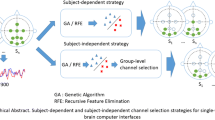Abstract
A challenge in designing a Brain-Computer Interface (BCI) is the choice of the channels, e.g. the most relevant sensors. Although a setup with many sensors can be more efficient for the detection of Event-Related Potential (ERP) like the P300, it is relevant to consider only a low number of sensors for a commercial or clinical BCI application. Indeed, a reduced number of sensors can naturally increase the user comfort by reducing the time required for the installation of the EEG (electroencephalogram) cap and can decrease the price of the device. In this study, the influence of spatial filtering during the process of sensor selection is addressed. Two of them maximize the Signal to Signal-plus-Noise Ratio (SSNR) for the different sensor subsets while the third one maximizes the differences between the averaged P300 waveform and the non P300 waveform. We show that the locations of the most relevant sensors subsets for the detection of the P300 are highly dependent on the use of spatial filtering. Applied on data from 20 healthy subjects, this study proves that subsets obtained where sensors are suppressed in relation to their individual SSNR are less efficient than when sensors are suppressed in relation to their contribution once the different selected sensors are combined for enhancing the signal. In other words, it highlights the difference between estimating the P300 projection on the scalp and evaluating the more efficient sensor subsets for a P300-BCI. Finally, this study explores the issue of channel commonality across subjects. The results support the conclusion that spatial filters during the sensor selection procedure allow selecting better sensors for a visual P300 Brain-Computer Interface.







Similar content being viewed by others
Notes
Note that in this study, the different ISI are not exploited as a parameter.
References
Allison BZ, Wolpaw EW, Wolpaw JR (2007) Brain-computer interface systems: progress and prospects. Expert Rev Med Devices 4(4):463–474
Birbaumer N, Cohen LG (2007) Brain-computer interfaces: communication and restoration of movement in paralysis. J Physiol London 579(3):621–636
Guger C, Edlinger G, Harkam W, Niedermayer I, Pfurtscheller G (2003) How many people are able to operate an EEG-based brain-computer interface (BCI)?. IEEE Trans Neural Syst Rehabil Eng 11(2):145–147
Guger C, Daban S, Sellers E, Holznera C, Krausza G, Carabalonac R, Gramaticac F, Edlinger G (2009) How many people are able to control a P300-based brain.computer interface (BCI)?. Neurosci Lett 462:94–98
Sannelli C, Dickhaus T, Halder S, Hammer E-M, Müller K-R, Blankertz B (2010) On optimal channel configurations for SMR-based brain-computer interfaces. Brain Topogr 23(2):186–193
Shih EI, Shoeb AH, Guttag JV (2009) Sensor selection for energy-efficient ambulatory medical monitoring. In Proceedings of the 7th International Conference on Mobile Systems, Applications and Services. ACM, Krakow, pp 347–358
Hoffmann U, Vesin JM, Diserens K, Ebrahimi T (2008) An efficient P300-based brain-computer interface for disabled subjects. J Neurosci Method 167(1):115–125
Lal TN, Schroder M, Hinterberger T, Weston J, Bogdan M, Birbaumer N, Scholkopf B (2004) Support vector channel selection in BCI. IEEE Trans Biomed Eng 51(6):1003–1010
Schroder M, Lal TN, Hinterberger T, Bogdan M, Jeremy Hill JNN, Birbaumer N, Rosenstiel W, Scholkopf B (2005) Robust EEG channel selection across subjects for brain-computer interfaces. EURASIP J Appl Signal Process 19:3103–3112
Donchin E, Spencer KM, Wijesinghe R (2000) Assessing the speed of a P300-based brain-computer interface. IEEE Trans Neural Sys Rehab Eng 8(2):174–179
Rivet B, Souloumiac A, Attina V, Gibert G (2009) xDAWN algorithm to enhance evoked potentials: application to brain-computer interface.. IEEE Trans Biomed Eng 56(8):2035–43
Maby E, Gibert G, Aguera P-E, Perrin M, Bertrand O, Mattout J (2010) The OpenViBE P300-Speller scenario: a thorough online evaluation. In: Human Brain Mapping Conference, 2010.
Sharbrough F, Chatrian G, Lesser RP et al (1990) Guidelines for standard electrode position nomenclature. American EEG Society, Bloomfield
Farwell L, Donchin E (1988) Talking off the top of your head: toward a mental prosthesis utilizing event-related brain potentials. Electroencephalogr Clin Neurophysiol 70:510–523
Cecotti H, Gräser A (2010) Convolutional neural networks for P300 detection with application to brain-computer interfaces. IEEE Trans Pattern Anal Mach Intell 3:433–445
Rakotomamonjy A, Guigue V (2008) BCI competition iii : Dataset ii - ensemble of SVMs for BCI P300 speller. IEEE Trans Biomed Eng 55(3):1147–1154
MacKay DJC (1992) Bayesian interpolation. Neural Comput 4(3):415–447
Rivet B, Souloumiac A, Gibert G, Attina V, Bertrand O (2009) Sensor selection for P300 speller brain computer interface. In Proceedings of European Symposium on Artificial Neural Networks, Bruges. pp 431–438
Bianchi L, Sami S, Hillebrand A, Fawcett IP, Quitadamo LR, Seri S (2010) Which physiological components are more suitable for visual ERP based brain-computer interface? a preliminary MEG/EEG study. Brain Topogr 23(2):180–185
Krusienski DJ, Sellers EW, McFarland DJ, Vaughan TM, Wolpaw JR (2008) Toward enhanced P300 speller performance. J Neurosci Method 167:15–21
Sutton S, Braren M, Zubin J, John ER (1965) Evoked potential correlates of stimulus uncertainty. Science 150:1187–1188
Polich J (2007) Updating P300: An integrative theory of P3a and P3b. Clin Neurophysiol 118:2128–2148
Maeno T, Kaneko A, Iramina K, Eto F, Ueno S (2003) Source modeling of the P300 event-related response using magnetoencephalography and electroencephalography measurements. IEEE Trans on Magn 39(5):3396–3398
Yamaguchii S, Knight RT (1991) Anterior and posterior association cortex contributions to the somatosensory P300. J Neurosci 11(7):2039–2054
Tarkka IM, Stokic DS (1998) Source localization of P300 from oddball, single stimulus, and omitted-stimulus paradigms. Brain Topogr 1(2):141–151
Acknowledgment
The authors thank the anonymous reviewers for their pertinent comments, which allow to drastically improve the quality of this paper.
This work has been supported by French National Research Agency (ANR) through TecSan program (project RoBIK ANR-09-TECS-013) and through DEFIS program (project Co-Adapt ANR-09-EMER-002).
Author information
Authors and Affiliations
Corresponding author
Rights and permissions
About this article
Cite this article
Rivet, B., Cecotti, H., Maby, E. et al. Impact of Spatial Filters During Sensor Selection in a Visual P300 Brain-Computer Interface. Brain Topogr 25, 55–63 (2012). https://doi.org/10.1007/s10548-011-0193-y
Received:
Accepted:
Published:
Issue Date:
DOI: https://doi.org/10.1007/s10548-011-0193-y




